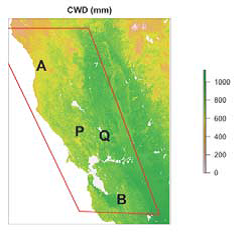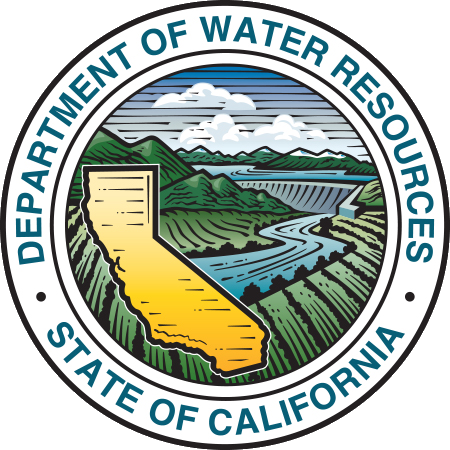Regional Hydrology
Characterization of Hydrologic Conditions for Species Distributions Along Environmental Gradients
Plant distributions at local to global scales are influenced by the interplay among plant traits (physiology, anatomy, morphology), the physical setting, biotic interactions, and historical factors such as disturbances and responses to past climate change. Physiological strategies and functional traits provide a key starting point to understand how distributions are shaped along gradients of climate and soils. Essential functions of water transport, nutrient uptake, carbon gain and growth underlie demography (growth, survival and reproduction), interactions with neighbors, and dispersal in space and time. In drought-prone regions of the world, the study of plant hydraulics, gas exchange and strategies for avoidance or tolerance of water deficits has proven particularly powerful for understanding constraints on plant growth and distributions, as well as the effects of extreme events (e.g., drought) on performance. Climate-the seasonal march of temperature, precipitation, wind, etc., and the frequency and intensity of extreme conditions-sets boundary conditions for plant function, and soil properties (e.g., depth, porosity and water storage) play a critical role in modulating water availability through the year. While climate has undergone dramatic shifts through Earth history, we are now in an era of unprecedented climate change with regard to the rate, magnitude and global extent of change. Temperatures are rising, and broadly speaking at a global scale, dry places are projected to get drier and wet places wetter. Where wet and dry meet, as they do in California, there is considerable uncertainty about future precipitation trends. However, as discussed in greater detail below, rising temperatures will provide greater energy inputs that drive evapotranspiration from soils and plants, and as a result climatic water deficits are expected to rise in many places, even where rainfall may be stable or increase. The combination of water deficits and high temperatures is already impacting plants and animals worldwide, and in particular widespread tree mortality has been observed on all continents.

Figure 1. Study area in northern and central California coast, A is Angelo Reserve, P is Pepperwood Preserve, Q is Quail Ridge Reserve, and B is Blue Oak Regional Reserve.
The impacts of climate change on local communities will be driven by differential responses of species to changing conditions. In this proposal, we contrast and seek to connect two paradigms for understanding the relative and/or absolute sensitivity of species at a site: plant strategy theory and bioclimatic theory. These two paradigms generate contrasting perspectives on impacts of future climate change:
- Plant strategy theory focuses on physiological and functional strategies, including rooting depth, hydraulic vulnerability, and leaf economics, to explain differential sensitivity of species to rising temperatures and more frequent or acute drought. Physiologically, reduced water availability is generally viewed as a negative change viz-a-viz plant function, so at best some species will be resilient and/or tolerate the change, while others are more sensitive (e.g., the classic studies of pinyon-juniper responses (McDowell and others, 2008; West and others, 2008)).
- Bioclimatic theory, in contrast, projects responses to climate change based on the location of a population relative to the total range occupied by a species (in climate and geographic space); species distribution models generally project positive impacts of climate change for populations at the leading edge of a species range (e.g., the northern or high-elevation margin during an episode of warming), and negative impacts at the trailing edge. Any given species has both leading- and trailing-edge populations at a given point in time, implying that explanations in terms of physiological strategies must also consider the environmental context. Moreover, due to intrinsic physiological and ecological variability, different species exhibit highly variable responses to the same episodes of climate change.
The strongest linkages between plant strategies and climate change responses have been developed for dynamic global vegetation models, but as these rely on broad functional groups they are insufficient to bridge the gap between mechanistic studies of physiological strategies and the highly-variable responses observed in past episodes of climate change and predicted by bioclimatic models for the coming century. Linking mechanistic and ecological responses in drought-prone ecosystems is an urgent priority in a warming climate.
Objective and Scope
We will examine the hydraulic and drought tolerance strategies of co-occurring woody plant species of contrasting functional groups, including a range of species that are projected to be 'winners' vs. 'losers' in response to future climate change, based on bioclimatic modeling of species and vegetation distributions. Through a unique, interdisciplinary integration of ecophysiology and comparative functional ecology, coupled with measurement, modeling and projection of climatic water balance across spatial and temporal gradients, we will develop a powerful new physiological modeling framework. Our models and data will allow us to integrate climate, soils, inferred functional root distributions, and physiological traits to project the potential impacts of climate change on tree physiology and performance, and integrate the projections into long-term studies of landscape-scale plant community dynamics. We will use this modeling framework to test the contrasting hypotheses of physiological strategy vs. bioclimatic limits as predictors of relative and absolute responses to a warmer and drier climate.
Relevance and Benefits
The proposed work directly addresses several aspects of the USGS Science Strategy for the Decade, 2007-2017 (USGS Circular 1309), specifically "Understanding Ecosystems and Predicting Ecosystem Change, Climate Variability and Change." Species in California, particularly those in oak woodland environments, are experiencing stress as a result on the ongoing drought, and land and resource managers are seeking understanding as to the most scientifically defensible strategies for successful landscape management. This study will provide key insights to the strategies woody species use to cope in stressful environments and should deliver useful understanding for land managers seeking to adapt to a changing climate.
Approach
We have chosen a field-based, comparative approach for this project focused on contrasting species responses across spatial gradients as the best strategy to achieve our goals. Comparative approaches rely on variation in space and time to identify parameters of importance that explain ecological and environmental variation in species responses. This approach provides a balance of mechanistic understanding with broad application, including the ability to test hypotheses of variation in species strategies and effects of contrasting environmental gradients, and to interpolate the results across local landscapes. Using a space-for-time substitution (i.e. warmer locations on the landscape serve as proxies for future climates) builds in physiological and morphological acclimation (and possibly genetic adaptation) in species responses on climate gradients. This is appropriate for understanding longer-term biotic responses to climate, as plants will have time to adjust allocation and morphology in response to changing climate over decades. In this way, a space-for-time approach may be more conservative, but ultimately complementary and equally useful, in comparison with experimental approaches that impose acute stresses on plants and usually are only able to assess relatively short-term responses. The CAWSC will support the study effort using an existing model (Basin Characterization Model; Flint and others, 2013) that will be refined as discussed below. The Basin Characterization Model (BCM) is regional water balance model that calculates the hydrologic response to changes in climate at any spatial resolution, resulting in estimates of recharge and runoff, and climatic water deficit (CWD) a significant predictor of vegetation distribution (Loarie and others, 2008) and 20th century patterns of tree mortality (Das and others, 2013; van Mantgem and others, 2013).
Develop daily BCMs at 10-m spatial resolution for Blue Oak Ranch, in the mountains of the southeastern San Francisco Bay, and Canyon Ranch, in the central Coast Range. The BCM for the Pepperwood Preserve, the site in the southern Russian River basin, is complete. Run daily models for 2000-2015 to evaluate a representative set of sampling and instrumentation locations that span the range of site hydrologic conditions for each. Blue Oak Ranch is currently instrumented at various locations, and these locations will be included in the evaluation. The goal of analyses is to identify locations for instrumentation that exhibit a range of topographic and climatic conditions describing each preserve for the species' of interest.
For each vegetation plot location with local soils properties, develop daily point-location models with soil layers, soil properties, and rooting configurations associated conditions at each vegetation plot. These model will include seasonal evapotranspiration coefficients for each species of vegetation.
Calibrate daily point-location models to measured soil moisture and water potential data for the first year of the study to best represent moisture status at the different site locations. Test models for validation with the second year of measured data. Develop historical range limits for the species of interest.
Apply 3 to 4 future daily climate projections from the CMIP5 collection of GCMs that have been statistically downscaled by Pierce et al. (2014) using the LOcalized Constructed Analogues (LOCA) method, and spatially downscaled using Flint and Flint (2012) to 10-m for each of the three study sites and each vegetation plot. Evaluate the potential for extreme conditions that exceed the historical range limits to explore the vulnerability of the different species and where along the climatic gradients vulnerabilities exist.
Analyze data and collaborate with ecophysiologists to best describe hydraulic strategies on the basis of first- and second-year field data to test the hypotheses of whether plants cope with changes in climate on the basis of water use and hydraulics or range shifts.
Cooperating Agencies
California Department of Water Resources
References
Flint, L. E., A. L. Flint, J. H. Thorne, and R. Boynton. 2013. Fine-scale hydrologic modeling for regional landscape applications: the California Basin Characterization Model development and performance. Ecological Processes 2:25.
Das, A. J., N. L. Stephenson, A. Flint, T. Das, and P. J. van Mantgem. 2013. Climatic correlates of tree mortality in water- and energy-limited forests. PLoS ONE 8:e69917.
Loarie, S. R., B. E. Carter, K. Hayhoe, S. McMahon, R. Moe, C. a Knight, and D. D. Ackerly. 2008. Climate change and the future of California's endemic flora. PloS one 3:e2502.
McDowell, N., W. T. Pockman, C. D. Allen, D. D. Breshears, N. Cobb, T. Kolb, J. Plaut, J. Sperry, A., West, D. G. Williams, and E. A. Yepez. 2008. Mechanisms of plant survival and mortality during drought: why do some plants survive while others succumb to drought? New Phytol 178:719-739.
van Mantgem, P. J., J. C. B. Nesmith, M. Keifer, E. E. Knapp, A. Flint, and L. Flint. 2013. Climatic stress increases forest fire severity across the western United States. Ecology letters 16:1151-6.
West, A. G., K. R. Hultine, J. S. Sperry, S. E. Bush, and J. R. Ehleringer. 2008. Transpiration and hydraulic strategies in a piñon-juniper woodland. Ecological Applications 18:911-927.


